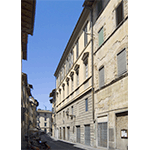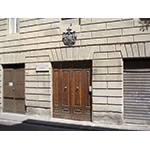Istituto Demidoff [Demidoff Institute]
In 1828 Count Niccol˛ Demidoff established, in the San Niccol˛ quarter, a free primary school for needy children. Since the very beginning, the Institute also served as a health department. In the following years other activities were added, among them the teaching of drawing, weaving, silk-processing, shoemaking and typography. Up to the middle of the 19th century the Demidoff family provided for the institution’s financial needs. In 1854 the administration was entrusted to the parish priest of San Niccol˛ and the school was managed by the Sisters of Charity. In 1870 Prince Carlo Demidoff arranged for the transfer of the Institute to the Royal Administration. The rearrangement of the premises in their current form dates from this time. In addition to carrying out traditional activities for the education and health of children, the Institute became a girls’ school towards the end of the 19th century. In the second half of the 20th century it housed a municipal primary school, which upon its closure was replaced by a residence for the elderly, a women’s educational community, a day centre for young people and one for the elderly.
On the first floor of the building that houses the Institute is the pharmacy, no longer in service today, founded in the second half of the 19th century. It still has its original wood furnishings (fine cabinets with neo-Gothic style panes of glass), containing pharmaceutical vases in porcelain (most of them from the Ginori Manufactury) and glass containers of Tuscan manufacture (bottles, vases, funnels, beakers, alembics and phials). The collection, dating from the second half of the 19th century, also includes a scale and mortars made of glass and porcelain. At the centre of the room is a bench where the medicinals were prepared.
****************************
Texts by Antonella Gozzoli
English translation by Catherine Frost
Last update 16/gen/2008





